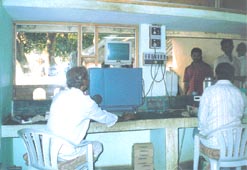Milk and money
 THIS is Anand in Gujarat, birthplace of the cooperative movement in dairying that has come to be known as the White Revolution. Having made the most of dairying, some 3,000 villages in Anand and Kheda districts are making a different kind of transition. Now it is not just about increasing productivity. The emphasis is on efficiency. The tool is the automatic milk collection system (AMCS), an it initiative by Amul (the Anand Milk Union Limited). A computerised system, it allows the reading of milk quantity and quality (for fat content). "It maintains daily records of milk societies at the village level,' says Subbarao Hegde, head of information and systems division at the Gujarat Cooperative Milk Marketing Federation Limited (GCMMFL), Anand.
THIS is Anand in Gujarat, birthplace of the cooperative movement in dairying that has come to be known as the White Revolution. Having made the most of dairying, some 3,000 villages in Anand and Kheda districts are making a different kind of transition. Now it is not just about increasing productivity. The emphasis is on efficiency. The tool is the automatic milk collection system (AMCS), an it initiative by Amul (the Anand Milk Union Limited). A computerised system, it allows the reading of milk quantity and quality (for fat content). "It maintains daily records of milk societies at the village level,' says Subbarao Hegde, head of information and systems division at the Gujarat Cooperative Milk Marketing Federation Limited (GCMMFL), Anand.
Mogar village is about 20 km from Anand. The cooperative dairy society here, which collects about 1,600 litres of milk everyday, has an amcs. Udai Singh, secretary of the society, says they purchased the device three years ago for Rs 35,000. "The society picked the tab. No loans, no subsidy.' It has made a significant difference. R S Sodhi, general manager of GCMMFL, explains that in the previous manual system, two to three days were spent on collecting information on the quality and quantity of milk deposited by each member. Payments were worked out manually, which consumed a lot of time. The producer was sometimes paid ten days after depositing the milk. "Making payments is now a matter of seconds with the amcs,' says Dilip Singh, cashier of the society.
About 200 members can deposit milk within one hour. In the previous system, milk was tested only after all collections had been made and test samples stored in plastic bottles. "This led to unhygienic conditions. The earlier method for testing milk for fat content was very cumbersome. Among the disadvantages was handling of corrosive chemicals. All these added to the cost and time,' says Jayen S Mehta, group product manager with GCMMFL.
"Everything gets done through the machine now; daily reports, monthly reports, year-end calculations,' says Udai Singh. Transactions have become very easy. Earlier, the producers would get suspicious about the measuring scale or the quality testing apparatus. A producer would not able to remember the quantity or quality of milk deposited. "It was easy for the person recording the information to manipulate the data and cheat the producer,' says Sodhi.
The cooperative society at the nearby Gopalpura village has spent Rs 1,40,000 on a power generator to deal with breakdown in electricity supply. This marks how well the village has taken to the computer-based AMCS it purchased for Rs 49,000 three years ago. The society had footed the bill without any assistance. Of the 1,000-odd societies in the Kheda milk union, about 160 have a computer-based amcs, Parmar informs: "We are planning for another 200 amcs machines. The computer is costly. So, in the case of small societies, one system is shared by two to three villages.'
